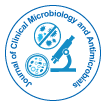
Journal of Clinical Microbiology and Antimicrobials
Open Access
+44-77-2385-9429

+44-77-2385-9429
Perspective - (2024)Volume 8, Issue 3
Fungal infections remain a significant health concern worldwide, affecting millions of individuals each year, especially those with weakened immune systems, such as cancer patients, organ transplant recipients and the elderly. The rise of antifungal resistance complicates the treatment of fungal infections, making it important to examine innovative strategies for disease prevention. A potential approach involves the use of fungal transformants, genetically modified fungi that serve as strong tools in understanding fungal pathogenesis, developing novel therapies and improving disease prevention strategies. This study searches into the applications of fungal transformants in disease prevention, focusing on their role in antifungal resistance research, vaccine development and the creation of novel therapeutic strategies.
Applications in antifungal resistance research
One of the most important applications of fungal transformants is in the study of antifungal resistance. The emergence of resistant strains of fungi, such as Candida albicans, Aspergillus fumigatus and Cryptococcus neoformans, poses a significant threat to public health, especially in immunocompromised patients. Fungal transformants can be engineered to carry mutations or foreign genes that mimic resistance mechanisms found in clinical strains. By creating fungal transformants that overexpress resistance genes or harbor mutations associated with drug resistance, researchers can simulate the development of resistance in laboratory settings. These models allow scientists to study the genetic basis of resistance and test modern compounds that could counteract these mechanisms. For example, fungal transformants can be used to identify drug-target interactions, screen for novel antifungal agents and evaluate the effectiveness of existing drugs against resistant strains. By understanding how fungi become resistant to treatments, researchers can develop strategies to circumvent these defenses, leading to more effective antifungal therapies and disease prevention measures.
Fungal transformants in vaccine development
Another potential application of fungal transformants in disease prevention is in the development of fungal vaccines. Vaccines are one of the most effective tools for preventing infectious diseases, and research into fungal vaccines has gained momentum in recent years. However, developing a safe and effective vaccine against fungal infections has been challenging due to the complexity of fungal pathogens and their ability to evade the host immune system. Fungal transformants can be used to produce antigenic proteins that stimulate an immune response in the host, leading to protection against future infections. These proteins can be expressed in fungi through genetic modification, which may serve as a cost-effective and scalable way to produce vaccine candidates. For example, recombinant Saccharomyces cerevisiae, a model yeast, has been used to express proteins from pathogenic fungi, such as Candida albicans or Aspergillus fumigatus, for use in vaccine development. Additionally, fungal transformants can be engineered to produce immunomodulatory molecules that boost the immune response or target specific immune pathways, enhancing the effectiveness of fungal vaccines. These transformed fungi may serve as live attenuated vaccines, where the pathogen is rendered less virulent but still able to provoke an immune response, providing longlasting immunity without causing disease.
Transformants in antifungal drug development
In addition to creating antifungal resistance models and contributing to vaccine development, fungal transformants also play a significant role in antifungal drug development. Through genetic modification, researchers can engineer fungi to produce novel metabolites or enzymes that have antifungal activity. These fungal-derived compounds may serve as potential therapeutic agents for treating fungal infections. Fungal transformants can also be used to identify and optimize drug targets. By altering specific genes in the fungus, researchers can evaluate how these changes impact the efficacy of existing antifungal drugs. For example, transforming a fungus to overexpress or knock out a gene involved in cell wall synthesis could help identify potential targets for antifungal drugs that disrupt this process. These modified strains can then be tested for their susceptibility to various antifungal agents, helping to streamline the drug discovery process. Furthermore, fungal transformants can aid in drug screening efforts by providing a consistent, reproducible model for testing antifungal compounds. Researchers can introduce different mutations into fungi, creating a variety of strains with different susceptibilities to drugs, which enables high-throughput screening for new antifungal agents. This application is particularly important given the limited number of antifungal drugs available on the market and the increasing prevalence of drug-resistant fungal infections. Fungal infections remain a major challenge in healthcare, particularly for immunocompromised individuals and those affected by drugresistant fungal strains. The use of fungal transformants offers significant promise in improving disease prevention strategies. Through genetic modification, fungal transformants are advancing research in antifungal resistance, vaccine development, drug discovery and understanding the pathogenesis of fungal infections. As these technologies continue to evolve, they will play an important role in creating more effective antifungal therapies, vaccines and preventive strategies, ultimately improving patient outcomes and reducing the global burden of fungal diseases.
Citation: Rosy C (2024). Applications of Fungal Transformants in Disease Prevention. J Clin Microbiol Antimicrob. 8: 208.
Received: 21-Aug-2024, Manuscript No. JCMA-24-35610; Editor assigned: 23-Aug-2024, Pre QC No. JCMA-24-35610 (PQ); Reviewed: 06-Sep-2024, QC No. JCMA-24-35610; , Manuscript No. JCMA-24-35610 (R); Published: 23-Sep-2024 , DOI: 10.35248/ JCMA.24.8.208
Copyright: © 2024 Rosy C. This is an open-access article distributed under the terms of the Creative Commons Attribution License, which permits unrestricted use, distribution, and reproduction in any medium, provided the original author and source are credited.